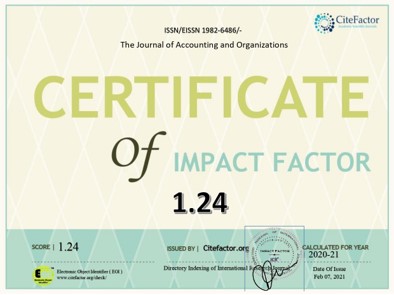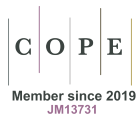Anxiety in accounting graduate
DOI:
https://doi.org/10.11606/issn.1982-6486.rco.2020.172020Keywords:
Anxiety, Master of Science, Doctorate, Self-efficacy, MotivationAbstract
This research analyzes the effect of motivation, self-efficacy, and sociodemographic variables on the anxiety of master’s and doctoral accounting students. The sample consisted of 246 master’s students and 76 doctoral students from all graduate accounting programs in Brazil. The study used the State-Trait Anxiety Inventory to collect data and determine the participants’ level of anxiety; the General Self-Efficacy Scale to find their level of self-efficacy; and the Academic Motivation Scale to assess their level of intrinsic, extrinsic, and amotivation. Data analysis used backward stepwise linear regression. The results revealed a predominance of anxiety in female students and concluded that anxiety is negative and significantly affected by self-efficacy. It is also positive and significantly affected by extrinsic motivation by external control and by amotivation. Finally, the research identified significant predictors to analyze anxiety such as the level of motivation to continue studying, being under 24 years old, the type of graduate (whether master’s or doctoral), receiving psychiatric/psychological support, receiving an academic scholarship, performance, and gender.
Downloads
References
Andrade, L., Gorenstein, C., Viera Filho, A. H., Tung, T. C., & Artes, R. (2001). Psychometric properties of the Portuguese version of the State-Trait Anxiety Inventory applied to college students : factor analysis and relation to the Beck Depression Inventory. Brazilian Journal of Medical and Biological Research, 34(3), 367-374.
Andrade, A. D. S., Tiraboschi, G. A., Antunes, N. A., Viana, P. V. B. A., Zanoto, P. A., & Curilla, R. T. (2016). Vivências acadêmicas e sofrimento psíquico de estudantes de Psicologia. Psicologia: ciência e profissão, 36(4), 831-846.
Araujo, I. R. de. (2015). A motivação de licenciandos em música sob a perspectiva da teoria da autodeterminação. Universidade Federal do Rio Grande do Norte.
Bandura, A. (1977). Self-efficacy: Toward a unifying theory of behavioral change. Psychological Review, 84(2), 191-215 ST-Self-efficacy: Toward a unifying the. DOI: https://doi.org/10.1037/0033-295x.84.2.191
Betz, N. E. (1978). Prevalence, distribution, and correlates of math anxiety in college students. Journal of Counseling Psychology, 25(5), 441-448. DOI: https://doi.org/10.1037/0022-0167.25.5.441
Biaggio, A. M. B., Natalício, L., & Spielberger, C. D. (1977). Desenvolvimento da forma experimental em português do Inventário de Ansiedade Traço-Estado (IDATE) de Spielberger. Arquivos Brasileiros de Psicologia Aplicada, 29(3), 31-44.
Borine, M. S. (2011). Ansiedade, neuroticismo e suporte familiar: Evidência de validade do Inventário de Ansiedade Traço-Estado (IDATE). Universidade São Francisco. Retrieved from http://dsv.usf.edu.br/galeria/getImage/427/606054467274901.pdf
Bueno, M. (2002). As Teorias de motivação humana e a sua contribuição para a empresa humanizada: um tributo a Abraham Maslow. Revista do Centro de Ensino Superior de Catalão - CESUC, 6, 1-25.
Bzuneck, J. A. (2001). As crenças de auto-eficácia e o seu papel na motivação do aluno. In E. Vozes (Ed.), A motivação do aluno: contribuições da psicologia contemporânea. (Vol. 1o, pp. 166–133). Petrópolis. Retrieved from http://www.uky.edu/~eushe2/Pajares/Bzuneck2.pdf
Castillo, A., Recondo, R., Asbahr, F. R., & Manfro, G. (2000). Transtornos de ansiedade. Revista Brasileira de Psiquiatria (Supl II), 22(m), 20-25. DOI: https://doi.org/10.1590/S1516-44462000000600006
Clark, D. A., & Beck, A. T. (2012). Terapia cognitiva para os transtornos de ansiedade. Porto Alegre: Artmed.
Conselho de Educação Superior (1965). Parecer n. 977/65. Definição dos cursos de pós-graduação necessidade da pós-graduação.
Conselho Federal de Contabilidade (2003). Legislaçaõ da profissão contábil (1st ed.). Brasília: Conselho Federal de Contabilidade. Retrieved from https://cfc.org.br/wp-content/uploads/2015/12/legis_profcontabil.pdf
Evans, T. M., Bira, L., Gastelum, J. B., Weiss, L. T., & Vanderford, N. L. (2018). Evidence for a mental health crisis in graduate education. Nature Biotechnology, 36(3), 282-284. DOI: https://doi.org/10.1038/nbt.4089
Fairchild, A. J., Horst, S. J., Finney, S. J., & Barron, K. E. (2005). Evaluating existing and new validity evidence for the Academic Motivation Scale. Contemporary Educational Psychology, 30(3), 331-358. DOI: https://doi.org/10.1016/j.cedpsych.2004.11.001
Fioravanti, A. C. M. (2006). Propriedades Psicométricas do Inventário de Ansiedade Traço-Estado ( IDATE ) A. Pontifícia Universidade Católica do Rio de Janeiro.
Garcia-Williams, A. G., Moffitt, L., & Kaslow, N. J. (2014). Mental health and suicidal behavior among graduate students. Academic psychiatry, 38(5), 554-560.
Horta, R. L., Horta, B. L., & Horta, C. L. (2012). Uso de drogas e sofrimento psíquico numa universidade do Sul do Brasil. Psicologia em Revista, 18(2), 264-276.
Iqbal, S., Gupta, S., & Venkatarao, E. (2018). Stress , anxiety & depression among medical undergraduate students & their socio-demographic correlates. Indian Journal of Medical Research, 141(3), 354-357.
Iudícibus, S. de, Martins, E., & Carvalho, L. N. (2005). Contabilidade: Aspectos relevantes da epopeia de sua evolução. Revista Contabilidade & Finanças, 38, 7-19.
Lei n. 9.394 (1996). Estabelece as diretrizes e bases da educação nacional. Brasília.
Levecque, K., Anseel, F., Beuckelaer, A., Van der Heyden, J., & Gisle, L. (2017). Work organization and mental health problems in PhD students. Research Policy, 46(4), 868-879. DOI: https://doi.org/10.1016/j.respol.2017.02.008
Lewinsohn, P. M., Gotlib, I. H., Lewinsohn, M., Seeley, J. R., & Allen, N. B. (1998). Gender Differences in Anxiety Disorders and Anxiety Symptoms in Adolescents. Journal of Abnormal Psychology, 107(I), 109-117. DOI: https://doi.org/10.1037//0021-843X.107.1.109
Maslow, A. H. (1943). A theory of human motivation. Psychological Review, 50(4), 370-396. DOI: https://doi.org/10.1037/h0054346
Neiva, J. F. de O. (2010). Estabelecimento de metas e ansiedade traço na aquisição de habilidades motoras. Universidade de São Paulo.
Nogueira, C., & Mesquita, A. P. (1992). Autoeficácia e ansiedade: aplicações na consulta psicológica. Jornal de Psicologia, 10(3), 16-22.
Oliveira, C. A. D. (2019). Ansiedade, depressão e estresse, uso de álcool e outras drogas e a satisfação de discentes de pós-graduação stricto sensu. Dissertação de Mestrado, Universidade Federal do Amapá, Macapá, AP, Brasil.
Patton, G. C., Coffey, C., Sawyer, S. M., Viner, R. M., Haller, D. M., Bose, K., ... & Mathers, C. D. (2009). Global patterns of mortality in young people: a systematic analysis of population health data. The lancet, 374(9693), 881-892.
Reis, C. F., Miranda, G. J., & Freitas, S. C. (2017). Ansiedade e desempenho acadêmico : Um estudo com alunos de Ciências Contábeis. Advances in Scientic and Applied Accouting, 10(3), 319-333.
Ryan, R. M., & Deci, E. L. (2000). Intrinsic and extrinsic motivations: Classic definitions and new directions. Contemporary Educational Psychology, 25(1), 54-67. DOI: https://doi.org/10.1006/ceps.1999.1020
Schunk, D. H. (1991). Self-efficacy and Academic Achievement. Sociological Perspectives, 26(3 & 4), 207-231. DOI: https://doi.org/10.1177/0731121416629993
Schunk, D. H., & Pajares, F. (2001). The development of academic Self-Efficacy. In A. Wigfield & J. S. Eccles (Eds.), Development of achievement motivation (7th ed.). San Diego: Academic Press.
Schwarzer, R., Bäßler, J., Kwiatek, P., Schröder, K., & Zhang, J. X. (1997). The assessment of optimistic self-beliefs: Comparison of the German, Spanish, and Chinese versions of the general self-efficacy scale. Applied Psychology, 46(1), 69-88. DOI: https://doi.org/10.1111/j.1464-0597.1997.tb01096.x
Serpa, A. L. de O. (2012). Autoeficácia , autoconceito e ansiedade em uma avaliação em larga escala e sua relação com o desempenho escolar. Universidade Federal de Juiz de Fora.
Simon, A., & Thomas, A. (1983). Test data for the State-Trait Anxiety Inventory for British Further Education, Certificate of Education and B.Ed. students. Personality and Individual Differences, 4(2), 199-200. DOI: https://doi.org/10.1016/0191-8869(83)90020-X
Smith, R. E. (1989). Effects of coping skills training on generalized self-efficacy and locus of control. Journal of Personality and Social Psychology, 56(2), 228-233. DOI: https://doi.org/10.1037/0022-3514.56.2.228
Sobral, D. T. (2003). Motivação do aprendiz de medicina : Uso da Escala de Motivação Acadêmica. Psicologia: Teoria e Pesquisa, 19(1), 25-31. DOI: https://doi.org/10.1590/S0102-37722003000100005
Spielberger, C. D. (Ed.). (1966). Anxiety and Behavior. New York and London: Academic Press.
Spielberger, C. D. (1972). Anxiety: Current Trends in Theory and Research. Anxiety as an Emotional State, 250. DOI: https://doi.org/10.1017/CBO9781107415324.004
Spielberger, C. D., & Gorsuch, R. L. (1966). Mediating processes in verbal conditioning. Report to National Institute of Mental Health.
Spielberger, C. D., Gorsuch, R. L., & Lushene, R. E. (1970). Manual for the state-trait anxiety inventory.
Spielberger, C. D., Gorsuch, R. L., & Lushene, R. E. (1979). Inventário de ansiedade traço-estado. Rio de Janeiro: CEPA.
Teixeira, J., Dias, A., & Dell’Aglio, D. (2012). Propriedades Psicométricas da Escala de Autoeficácia Geral Percebida (EAGP). Psico, 43(7), 139-146. DOI: https://doi.org/10.1111/j.1746-1561.2005.00034.x
Tyssen, R., & Vaglum, P. (2002). Mental health problems among young doctors: an updated review of prospective studies. Harvard review of psychiatry, 10(3), 154-165.
Vallerand, R. J. (1997). Toward a hierarchical model of intrinsic and extrinsic motivation. Advances in Experimental Social Psychology, 29, 271-360. DOI: https://doi.org/10.1016/S0065-2601(08)60019-2
Vallerand, R. J., Pelletier, L. G., Blais, M. R., Briere, N. M., Senecal, C., & Vallières, É. F. (1992). The academic motivation scale: A measure of intrinsic, extrinsic, and amotivation in education. Educational and Psychological Measurement, 52, 1003-1017. DOI: https://doi.org/10.1177/0013164492052004025
Viana, G. S. (2012). Atitude e motivação em relação ao desempenho acadêmico de alunos do curso de graduação em administração em disciplinas de estatística. Universidade de São Paulo.
Weiner, B. (1990). History of motivational research in education. Journal of Educational Psychology, 82(4), 616-622. DOI: https://doi.org/10.1037/0022-0663.82.4.616
Weiner, I. B., & Craighead, W. E. (Eds.). (2009). The Corsini Encyclopedia of Psychology (3rd ed.). John Wiley & Sons Inc.
White, W. R. (1975). Motivation reconsidered: The concept of competence. In P. H. Mussem, J. J. Conger, & J. Kagan (Orgs.) (Eds.), Basic and contemporary issues in developmental psychology (pp. 230-266). Harper & Row.
Witter, G. P. (1984). Aprendizagem e motivação. In G. P. Witter & J. F. P. Lomanaco (Eds.), Psicologia da Aprendizagem (pp. 37-57). São Paulo: EPU.
Wooldridge, J. M. (2010). Econometric analysis of cross section and panel data. MIT press.
Downloads
Published
Issue
Section
License
Copyright (c) 2020 Revista de Contabilidade e Organizações

This work is licensed under a Creative Commons Attribution-NonCommercial-NoDerivatives 4.0 International License.
The RCO adopts the Free Open Access policy, under the standard Creative Commons agreement (CC BY-NC-ND 4.0). The agreement provides that:
- Submission of text authorizes its publication and implies commitment that the same material is not being submitted to another journal. The original is considered definitive.
- Authors retain the copyright and grant the journal the right of first publication, with the work simultaneously licensed under the Creative Commons Attribution License which allows the sharing of the work with acknowledgment of authorship and initial publication in this journal.
- Authors are authorized to take additional contracts separately, for non-exclusive distribution of the version of the work published in this journal (e.g. publish in an institutional repository or as a book chapter), with necessary recognition of authorship and initial publication in this journal.
- Authors are allowed and encouraged to publish and distribute their work online (e.g. in institutional repositories or on their personal page) before or during the editorial process, as this can generate productive changes as well as increase the impact and citation of published work (See The Effect of Free Access).
- The journal does not pay copyright to the authors of the published texts.
- The journal's copyright holder, except those already agreed in the Free Open Access Agreement (CC BY-NC-ND 4.0), is the Accounting Department of the Faculty of Economics, Administration and Accounting of Ribeirão Preto of the University of São Paulo.
No submission or publication fees are charged.
Up to 4 authors per article are accepted. Exceptionally duly justified cases may be reviewed by the Executive Committee of the RCO. Exceptional cases are considered as: multi-institutional projects; manuscripts resulting from the collaboration of research groups; or involving large teams for evidence collection, construction of primary data, and comparative experiments.
It is recommended that the authorship be ordered by contribution of each of the individuals listed as authors, especially in the design and planning of the research project, in obtaining or analyzing and interpreting data, and writing. Authors must declare the actual contributions of each author, filling the letter to the editor, at the beginning of the submission, taking responsibility for the information given.
Authors are allowed to change throughout the evaluation process and prior to the publication of the manuscript. The Authors should indicate the composition and final order of authorship in the document signed by all those involved when accepted for publication. If the composition and authoring order is different than previously reported in the system, all previously listed authors should be in agreement.
In the case of identification of authorship without merit or contribution (ghost, guest or gift authorship), the RCO follows the procedure recommended by COPE.







